
Its amazing to me that there are still places on earth where wildlife is blissfully unafraid of humans. Isla Isabel, a picturesque volcanic island situated 15 miles off Mexico’s Riviera Nayarit coast, is just such a place. The island is half a mile wide and about three-quarters of a mile in length. It was made a National Park in the 1980s and is a major breeding and nesting area for over 30,000 seabirds. It comes as no surprise that this was one of Jacques Cousteau’s favorite places and he filmed the area and its wildlife extensively for his tv series.
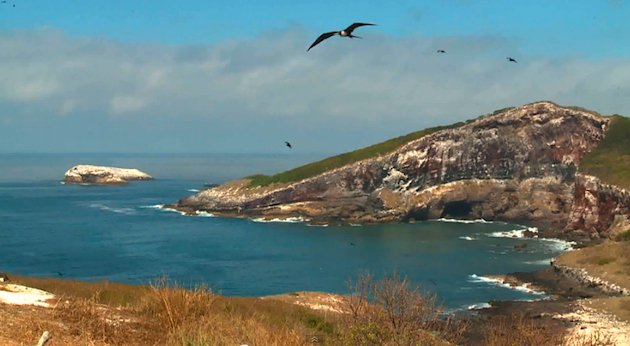 One of the sheltered bays on Isla Isabel
One of the sheltered bays on Isla Isabel
The island is easily reached via a 3 hour boat-ride from the picturesque and incredibly birdy coastal town of San Blas. There are numerous factors that make Isla Isabel such a diverse and phenomenal wildlife destination. Firstly, several ocean currents meet in the waters surrounding the volcanic outcrop. These nutrient-rich currents provide sustenance for a variety of marine-life, including the many thousand of seabirds that call this place home. Secondly, the mainland holds one of the largest and most biologically important mangrove stands on the central American coastline. These mangroves function as a sanctuary for fish and other animals that then make their way as adults across the channel to the coral reefs that surround the island. Coral reefs are rare in this part of the world and this makes for exceptional snorkeling and diving. Lastly, due to its previous inaccessibility to humans and the absence of natural predators, the wildlife is bizarrely unafraid of humans, allowing for a truly unforgettable experience.
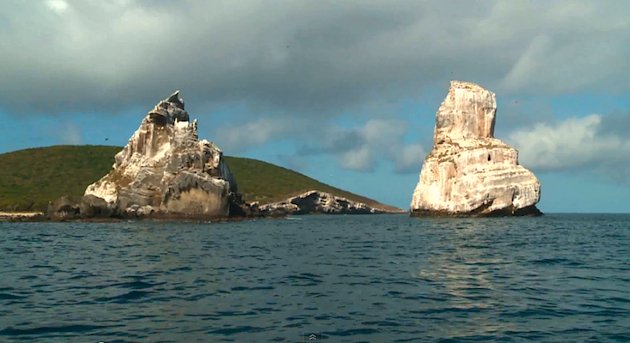 Red-billed Tropicbirds nest on these craggy cliffs
Red-billed Tropicbirds nest on these craggy cliffs
The boat-trip over to the island is far from uneventful and the pelagic birding is very rewarding. Brown Noddies, Sooty Terns and a good variety of other seabirds can be encountered. Northern Humpback Whales visit the waters surrounding Isla Isabel every year to mate and its not unusual to see dozens of these cetaceans breaching and whacking their tales on the ocean surface. The surrounding waters are also home to Whale Sharks year-round and on my recent visit I was very fortunate to hop overboard after coming across not one, but two, of these gentle giants.
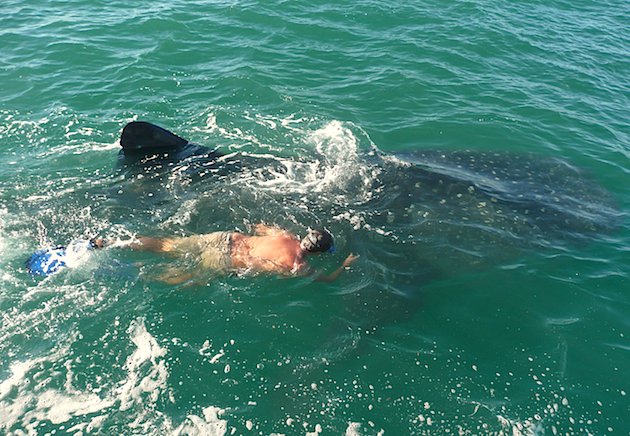 Swimming with a whale shark on the boat-trip to Isla Isabel
Swimming with a whale shark on the boat-trip to Isla Isabel
It is easy to know when the boat is nearing its destination because the skies start filling with ever-increasing numbers of Heerman’s Gulls, various booby species, Red-billed Tropicbirds and the ubiquitous Magnificent Frigatebirds. The frigates are by far the most numerous and evident of the island’s nesting species. Hundreds and hundreds of them nest in the stunted forested areas. The nests are so low in places that they are only a few feet off the ground. Male frigates wave their inflated red throat patches trying to attract females while cottonball-like chicks wait patiently for their parents to return. The drumming of the male frigatebirds’ bills on their throat sacs provides constant background noise to the visual vitality of the nesting scene.
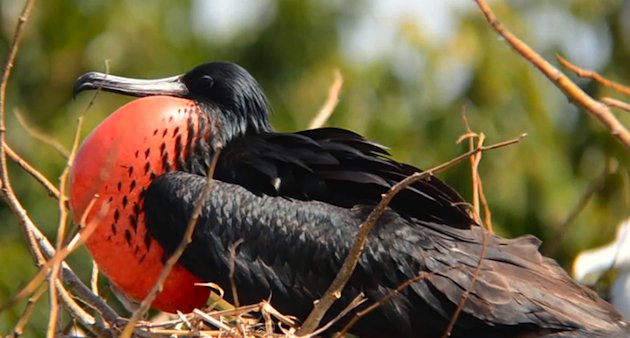 A male Magnificent Frigatebird in full breeding regalia
A male Magnificent Frigatebird in full breeding regalia
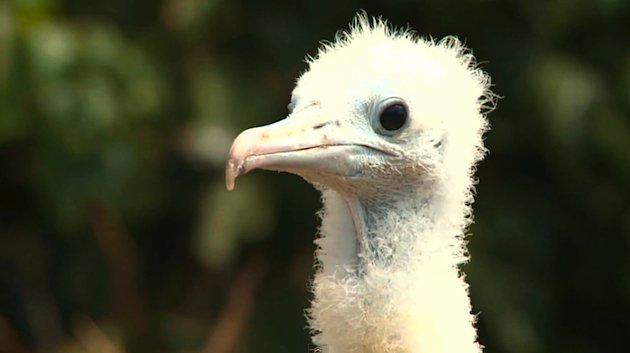 A young frigate within arms-length of the photographer
A young frigate within arms-length of the photographer
If you like boobies (no giggles please!), then Isla Isabel is the place for you. Three species of these gannet-like birds – Blue-footed, Brown and Red-footed – regularly nest on the island. The Brown Boobies nest sparsely in accessible areas close to the landing beach but to reach the Blue-footed Boobies, one needs to embark on a slightly strenuous hike to the top of a large hill. Besides offering the opportunity to walk amongst the boobies and their young, the summit offers a breathtaking view of the island, the cliffs and the surrounding ocean. It is a wonderful spot to watch the humpback whales breach in the crystal-clear waters. Its quite fascinating to be so close to the boobies that you can clearly see the difference in iris shape between male and female boobies (the males have a round, smaller iris and the females have a star-shaped, jagged edge to their larger iris). Interestingly, males and females also differ substantially in their voice – the males have a pleasant soft whistle whilst the females have a much harsher honking.
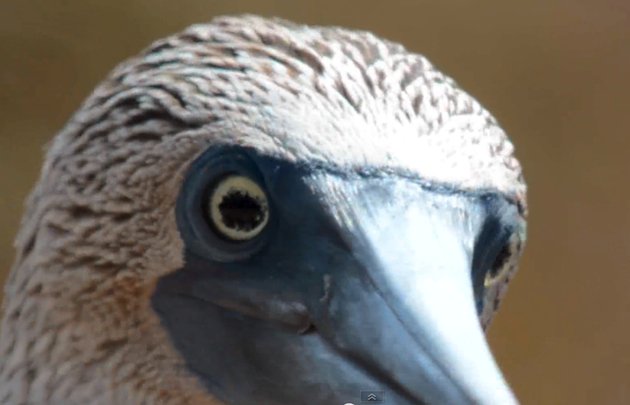 The eyes of a female Blue-footed Booby
The eyes of a female Blue-footed Booby
Besides the boobies and the frigatebirds, several other interesting seabird species nest on Isla Isabel, including Red-billed Tropicbirds, Sooty Terns, Heerman’s Gulls, Brown Noddies and Brown Pelicans. Also present are six species of reptiles, including the numerous Brown Iguanas.
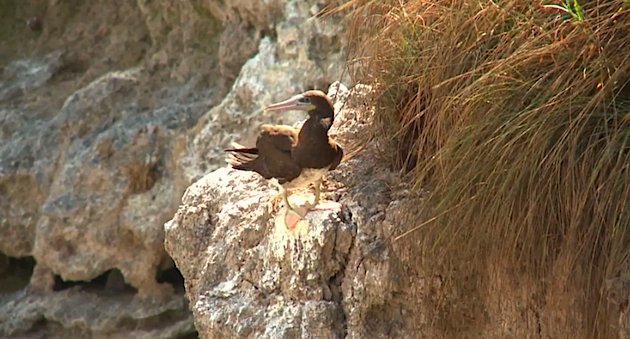 A Brown Booby, one of three booby species to be found on the island
A Brown Booby, one of three booby species to be found on the island
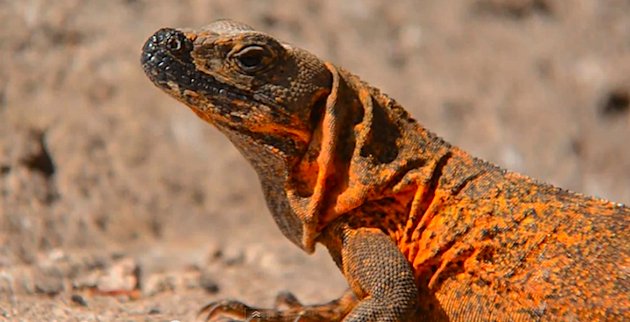 Brown Iguanas are common throughout the island
Brown Iguanas are common throughout the island
httpvh://www.youtube.com/watch?v=BL8fnOk6DyU
For those birders who want a Galapagos-like experience but without throngs of other visitors, Isla Isabel is a fantastic option. Surprisingly, very few people visit each year (permission is required but easily obtainable) and a visit can be tied into excellent endemic birding around San Blas. For more information on local accommodation, try the birder-friendly Hotel Garzacanela and for local guiding, contact Mark Stackhouse.


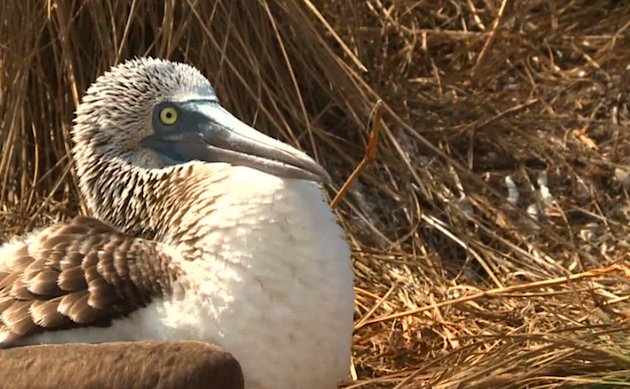











We are planning on sailing to Isla Isabella in about a week. Please share how you get the required permit. We will only have a few days before then to deal with this in Mazatlan. Thanks.
Hi Cheryl. Best place to contact is the hotel in San Blas. They can organize for you. http://garzacanela.com/home Enjoy!
Cheryl Did you find a place to get a permit?
Thanks
I went there many years back, sailing to it from Mazatlan on a friends sailboat on multiple occasions. We would anchor out and swim or row into one of the coves and then hike around. At the time we would run into local fishermen who would camp at the cove for several days at a time while they fished. The trading went something along the lines of a six pack of beer for fresh cooked fish and ice (for our beers). the walk to the top to see the bobbies was incredible. At the time, it was hard to move quickly as there were so many nesting birds. they were gentle but squawked a lot. The frigate birds were everywhere as well. The funny thing is, some of the folks I know who went there just called it bird-shit island as the numbers of birds were so overwhelming. thanks for the great write up and for bringing back some very good memories.